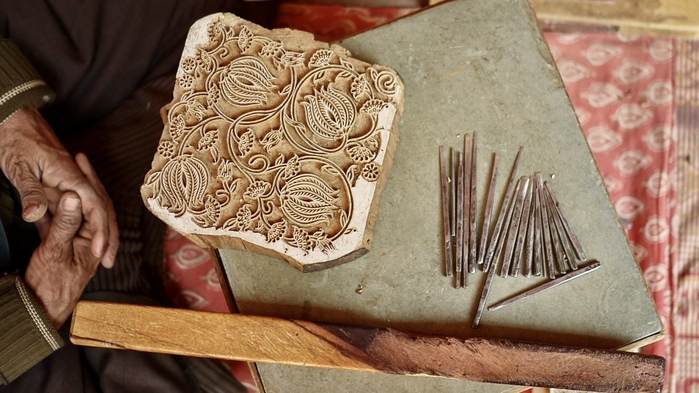As we entered the Anokhi Museum in Jaipur, we were immediately captivated by the beauty that surrounded us. In my head, I already put it on my list of one the best museums in Jaipur! The museum, housed in a stunning restored haveli, showcased the incredible art of hand-printing and textiles. I was in awe of the vibrant fabrics, intricate designs, and the skill of the artisans who created them. It was a truly enriching experience that deepened my appreciation for the traditional crafts of Rajasthan.
As I wandered through the museum’s galleries, I was guided through the rich history of textile traditions, from the intricate block printing of Rajasthan to the art of indigo dyeing. The exhibits not only celebrated the artistry of the artisans but also shed light on the cultural significance of these age-old practices.
Quick facts about the Anokhi Museum in Jaipur?
Here is a quick information on the opening hours and general information about the museum:
- Location: Anokhi Haveli Kheri Gate, Amer, Jaipur, Rajasthan 302028
- Operating Hours: Closed on Mondays, Tuesday to Saturday: 10:30 AM to 5 PM, and on Sundays: 11 AM – 4:30 PM
- Block carving & printing demonstrations Timings: All day except from 1:30 PM – 2 PM daily and 1:00 PM – 2:30 PM on Fridays
- Entrance Fee: Entry fee for adult Rs 30, for students Rs 20 and child Rs 15.
- Photography allowed? Yes it is allowed!
- Note: The museum is also closed for gallery maintenance annually between May 31st and July 15th. Exhibitions will be inaccessible during this time, but you are allowed to walk around the building.
Is Photography allowed in the Anokhi Museum?
The museum allows photographs and filming on phones and hand-held cameras. Images may be used for non–commercial purposes; however, copyright laws do restrict the reproduction of museum exhibits.
Please contact the museum for permission to use all imagery for commercial purposes. Advance permission is required to use video cameras and tripods. Flashes and photographic lights are also not permitted.
Drinks Kiosk at the Anokhi Museum:
Indulge in a moment of relaxation as you soak in the enchanting ambiance of Amber village from the serene forecourt of the museum.
To enhance your experience, they have an open-air Drinks Kiosk, offering a carefully curated selection of refreshments. Although the menu is currently limited, you can enjoy a range of delightful options such as, tea, coffee, refreshing lime-ginger cordial, and homemade biscuits.
Kiosk Opening Hours:
- Tuesday to Sunday: 11:00 AM- 4:30 PM
- Closed: Mondays, and major national and local holidays.
The Museum of Hand Printing in Jaipur
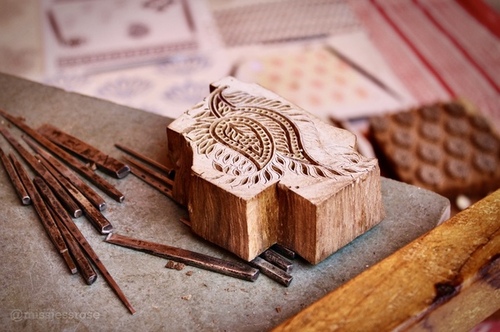
The establishment of the Anokhi Museum of Hand Printing was a visionary endeavor led by Rachel Bracken-Singh and her husband, Pritam Singh. It was Pritam’s father, John Singh, who acquired the neglected Chanwar Palkiwalon ki Haveli mansion in the late 1970s. They then embarked on an extensive three-year renovation project starting in 1989.
Collaborating with architects, the haveli was meticulously restored to its original state. The restoration process, employing indigenous materials, traditional construction techniques, and the expertise of local craftsmen, garnered the prestigious UNESCO award for ‘Cultural Heritage Conservation’ in the year 2000.
The museum is entirely dedicated to collecting and preserving block-printed cloth. Whether you are an art enthusiast or simply curious, a visit to this museum is a must. You will be inspired as you witness on-site demonstrations by talented artisans, showcasing their remarkable craftsmanship on the haveli’s rooftop. This unique experience is sure to awaken the artist within you.
Since its opening in 2005, this popular museum has gained immense popularity, due to its immersive exhibitions and the interactive participation of artisans. The Anokhi Museum of Handmade Paintings in Jaipur offers a captivating journey into the world of traditional printing techniques, allowing visitors to appreciate the meticulous artistry that goes into every hand-printed masterpiece.
Personal Experience in the Anokhi Museum
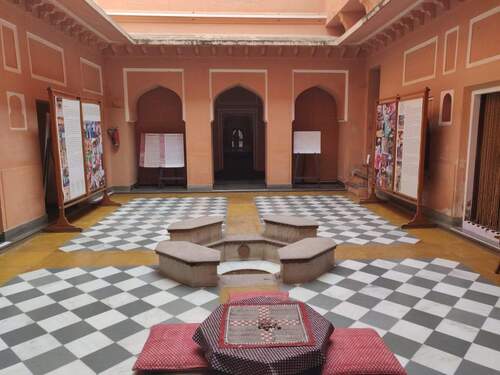
Upon purchasing our tickets for the Anokhi Museum, we entered a Chowk, a delightful open courtyard that graced the entrance. The presence of a Chowk is an intrinsic characteristic of Havelis in Rajasthan, adding a touch of charm and elegance. In this Chowk, we came across a section that showcased the before and after restoration photographs, offering a visual journey through the haveli’s revitalization. It was a captivating display, complemented by informative details that enriched our understanding of the restoration process and its historical significance.
The ground floor of the Anokhi Museum houses a captivating gallery dedicated to Jajam, showcasing the intricate artistry of this traditional craft. Adjacent to the gallery, there is a charming Anokhi shop, offering a delightful selection of handcrafted treasures.
You can also explore the rich history of block printing in India, delving into its origins, techniques, and cultural significance. It’s a comprehensive space that offers a multifaceted experience, celebrating the art, craftsmanship, and heritage associated with the haveli and block printing.
What is Jajam?
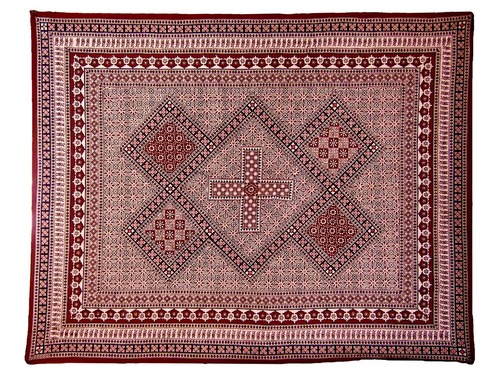
Jajam, a traditional durry or thin carpet, has long been utilized by locals as a comfortable seating option on the floor. However, with the rise of Western-style seating arrangements, the practice of using Jajam has gradually diminished in urban areas. Nevertheless, this cultural tradition still perseveres in certain rural places, offering a glimpse of its enduring legacy.
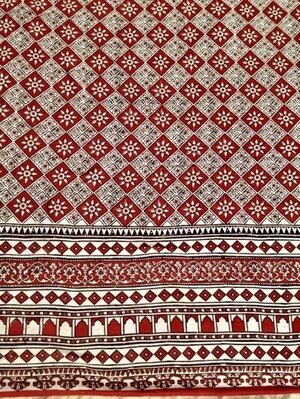
Crafted from thick fabric, Jajam holds a special place in the textile heritage of the region. Recognizing the importance of preserving this forgotten art form, Anokhi embarked on a collaborative journey with skilled artists to revive the craft of Jajam making. The designs adorning Jajam carpets draw inspiration from a myriad of sources, including architectural elements, captivating depictions of animals and birds, and traditional motifs. Each pattern intricately weaves together a story, infusing the Jajam with a sense of cultural richness and artistic expression.
Through Anokhi’s efforts, the art of Jajam making has been rekindled, ensuring its continued presence in the realm of traditional crafts. This revival not only pays homage to the past but also celebrates the enduring beauty and cultural significance of Jajam, bridging the gap between heritage and contemporary artistry.
Galleries in Anokhi Museum in Jaipur
After the Jajam section, we ascended the staircase to explore the galleries located on the first floor. True to the architectural style of ancient Havelis in the Dhundhar region, the staircase possessed a distinct character—steep in ascent, with small treads and high risers, offering a sense of historical authenticity.
As we entered the galleries, we discovered that the museum offers an abundant wealth of knowledge. The museum proved to be a goldmine, providing comprehensive insights into the intricate processes of block printing. Each region’s unique contributions to this art form, such as Sanganer, Bagru, Ajrakh, and Bagh, were meticulously showcased, allowing us to delve into their distinctive techniques and design elements.
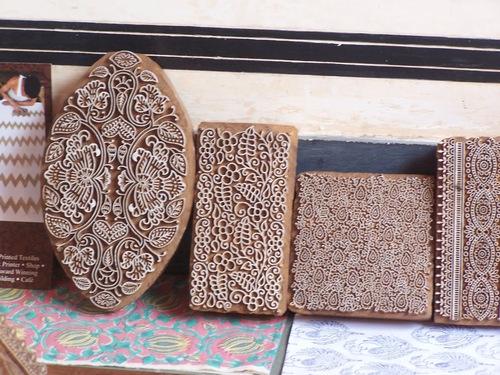
One of the sections also displayed an assortment of tools that played an integral role in the block printing process. These tools revealed the artistry and craftsmanship involved in bringing intricate designs to life on fabrics.
The museum’s dedication to preserving and showcasing the diversity of block printing across regions was truly commendable. It offered a comprehensive journey through the history, techniques, and cultural significance of this revered art form. It left us enriched with a deeper understanding and appreciation for the world of block printing.
Artistic Creations on the Terrace: Block Printing
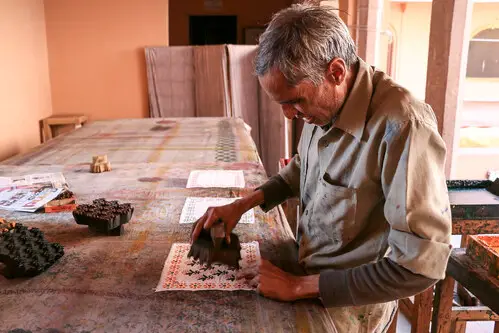
After concluding our exploration of the galleries, we went to the terrace. Where we witnessed an artist engrossed in the creation of blocks used in the intricate printing process. This terrace served as the foundation for the Indian block printing tradition, where the artistry begins to take shape.
Observing the artist at work, we couldn’t help but appreciate the immense skill and expertise required to craft blocks with delicate and intricate designs. It became evident that not every artisan possesses the finesse and precision necessary to master this art form. The creation of such intricate blocks demands a remarkable level of dedication, patience, and attention to detail.
The terrace provided us with a glimpse into the meticulous process behind the production of these blocks, highlighting the craftsmanship that underlies the art of block printing. It served as a reminder of the immense talent and artistry possessed by the artisans who contribute to the rich tapestry of Indian block printing.
Anokhi Museum in Jaipur Shop:
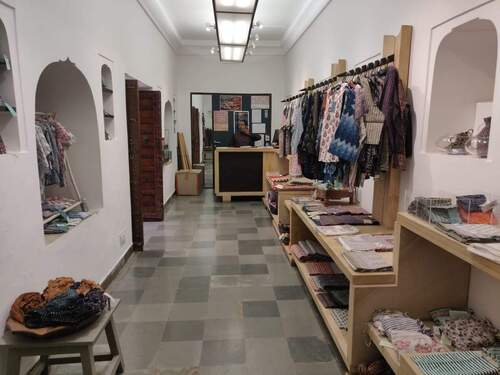
Located within the museum premises, this charming shop offers a curated selection of handcrafted treasures. From vibrant textiles to intricately designed garments, the shop showcases the exquisite craftsmanship that Rajasthan is renowned for.
The shelves are adorned with an array of colorful textiles and accessories. The shop is a true celebration of traditional block printing techniques, featuring a variety of beautifully printed fabrics, scarves, and home décor items. Each piece carries the distinct charm and authenticity of handcrafted artistry.
Whether you’re seeking a unique souvenir or looking to add a touch of Rajasthan’s artistic heritage to your collection, the Anokhi Museum Shop is a must-visit destination. The friendly staff is always ready to assist you in finding the perfect piece that resonates with your style and preferences. Prepare to be inspired by the remarkable craftsmanship and timeless beauty on display at the Anokhi Museum Shop in Jaipur.
History of Block Printing in India and Sanganer
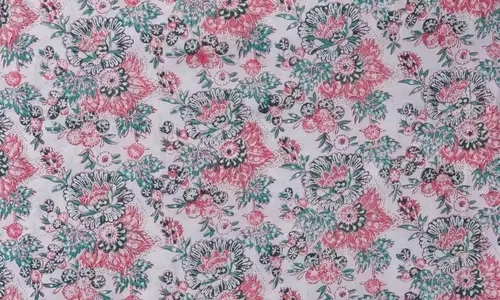
According to experts, a notable migration of block printers from Gujarat to Rajasthan and Madhya Pradesh took place due to prevailing political circumstances. Many block printers, seeking better opportunities, relocated to Rajasthan, resulting in a significant presence of this craft in the region.
The history of block printing in Jaipur is surrounded by various theories. Between the 16th and 18th centuries, Jaipur emerged as a prominent center for this art form. The availability of the Dravyawati river, which provided flowing water, and the abundance of sunshine played crucial roles in its development and establishment as a thriving hub for block printing.
Additionally, Jaipur’s strategic location as a trading town, founded in 1727 AD, further contributed to the growth and prosperity of the block printing industry. The artisans practicing this craft predominantly belong to the Chhipa community.
In addition to Sanganer, Bagru holds significant importance as another renowned center for block printing in Jaipur. Distinct technical differences can be seen between the block printing processes and techniques employed in Bagru and Sanganer. The rich heritage and intricate nuances of block printing in Jaipur continue to captivate and inspire, making it a fascinating subject worthy of further exploration.
Why Should You Visit Anokhi Museum?
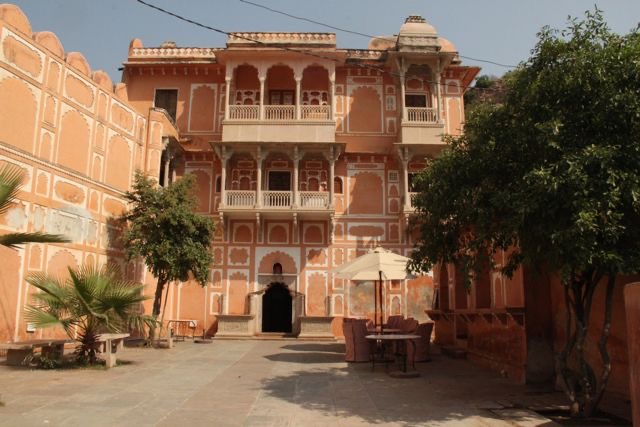
The Anokhi Museum in Jaipur is a must-visit for art, craft, history, and heritage enthusiasts. It offers an enriching experience for those who appreciate finer things in life. The museum’s galleries showcase the vast range and complexity of the block printing craft, featuring a diverse collection of hand-printed fabrics, including rare and contemporary pieces. From traditional to Western garments, the exhibits span two floors and provide a comprehensive understanding of the history and techniques of traditional Indian block printing.
During my visit, the highlight was witnessing the step-by-step printing process showcased in the museum. The journey of a simple grey cotton cloth transforming into a beautifully printed garment was truly remarkable. This experience is rarely encountered outside of a block printing workshop in Jaipur, making it all the more special.
Amidst the loss of many magnificent Havelis in Amer over time, the Anokhi Museum stands as a shining example of preservation and revival. It not only saves these historical structures but also connects them with people, fostering a deeper appreciation for their significance.
For an immersive exploration of art, culture, and architectural heritage, the Anokhi Museum is an exceptional destination that leaves a lasting impression.
FAQs: Anokhi Museum in Jaipur
Below are the most frequently asked questions regarding the Anokhi Museum in Jaipur.
No, you do not need to book an appointment to visit the museum. However, the museum closes every Monday and on public holidays.
Yes, it is an Anokhi shop. They offer a unique selection of limited-edition textiles, craft publications, and traditional block prints relating to the exhibits.
Yes, the Kiosk only serves hot & cold beverages in the museum forecourt. It is a serene and calming place to relax after the sightseeing.
